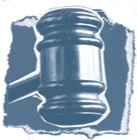Pat Bemis was a student at Baldwin High School in Pennsylvania and on the varsity volleyball team. Baldwin’s rivals attended Keystone Oaks High School in 2001. The statements on page 131 were posted on a volleyball message board by senior Jack Flaherty Jr., a member of Keystone’s volleyball team. Pat’s mother was an art teacher at Keystone Oaks. The statements were part of a series of messages Jack posted about a game between the rival teams. Three of the messages were posted from home, and one from a school computer with permission from his teacher. None of the messages contained any profanity or threats. They included typical bragging rights such as, “Someone better call the Guinness Book of World Records for the biggest lashing in men’s volleyball history.”
Keystone Oaks had a student handbook that included discipline, student responsibility, and technology provisions. After the school learned of Jack’s messages, he was kicked off the volleyball team, prohibited from participating in after-school events, and forbidden to use any school computers.
Jack and his parents sued the school district claiming a violation of Jack’s free speech. They also said the student handbook was so vague that students could be muzzled for expressing their opinions. In standing up for the right of students to use the Internet from home, Jack said he was fighting the case “because I knew kids were getting punished for reasons the school couldn’t justify.” The school believed it could discipline a student for bringing negative attention to the school and to the volleyball team.

How Would You Decide This Case?
Are you surprised at the school’s response to Jack’s online comments? Or did his taunts go too far? Why or why not? Would the situation be any different if all postings by Jack were made on a school computer rather than his own? His only comment from a school computer was, “How bad is Keystone Oaks going to beat Baldwin? I predict a lashing and for Bemis to shed tears.” Do you think this justified action by the school? Why or why not?

What the Court Decided
Before Jack’s case was scheduled for trial, he settled with the school district for $60,000 (for attorney fees and damages). The only issue remaining for the court to decide was whether the Keystone Student Handbook was unconstitutionally vague.
A rule or law that is considered overbroad or vague is one that punishes both protected and unprotected speech. For example, the student handbook at Keystone prohibited speech that was “inappropriate, harassing, offensive, or abusive.” No further definition of these terms was provided. The court found that the handbook policies “do not provide the students with adequate warning” of the conduct that is prohibited.
The principal of the school believed he could discipline a student for bringing disrespect and adverse attention to the school and its programs. But under the Tinker test (see Part 1), Jack’s comments did not rise to the level of substantial disruption at school. “The mere desire to avoid ‘discomfort’ or ‘unpleasantness’ is not enough to justify restricting student speech.”
The court went further and considered whether the school could discipline a student for off-campus activities. The principal and athletic coach testified that they could, if the expression affected the school negatively or brought shame to the school or its programs. The court disagreed, arguing that the student handbook was unconstitutionally vague since it “could be read to cover speech that occurs off the school’s campus and is not school related.”
Jack later said that he hoped “in the future Keystone Oaks will not punish students who exercise their constitutional rights to criticize the school.”
How Does This Decision Affect You?
The court’s ruling affirms your right to criticize, applaud, spoof, or comment about teachers, staff, classmates, and rivals. If the school has rules of conduct regarding use of its computers, they must be clear and unambiguous. Any prohibited behavior must be spelled out in the student handbook for all to see. Jack’s Web writings were no different from making the same comments in the hallway, on the volleyball court, or in the locker room. They may have been offensive, but they constituted protected speech.
The bottom line: Your speech may be protected, but think twice before criticizing someone’s mother—that’s always a hot button!
What Is Jack Doing Now?
Jack graduated from Keystone Oaks High School and went on to attend Indiana University of Pennsylvania.
Related Cases
In the Matter of Tony Harris (Michigan, 2009)
Tony Harris was a 19-year-old sophomore at Calvin College in Michigan. After breaking up with his girlfriend, he posted sexual comments about her on Facebook. He was already on school probation for a similar incident. In February 2009, he was expelled from the college for violating the school’s technology and conduct code. Tony maintained that the girl used his password to post the comment herself.
Thomas Siefert v. Lancaster High School (Ohio, 2003)
Thomas Siefert was a 17-year-old junior at Lancaster High School in Ohio. In 2003, he created the Web site www.lancasternewsletter.com where he included pictures of teachers and a message board with negative comments about the school and administrators. Although parts of the site were crude and tasteless, Thomas did all of the work away from school. The site was up for almost a year before he shut it down to avoid getting into trouble. The school suspended Thomas for 10 days and later voted to expel him for the remainder of the school year. Following a meeting with the school board, the expulsion was lifted and Thomas was allowed to return to school and make up the work he missed.
“What the Internet gives is the illusion of privacy, but in fact, it’s the exact opposite. There is less anonymity and privacy than ever. Eventually, everything that gets written and communicated can be traced to its originator.”
—Professor Thierry Guedj, Boston University
Kim v. Newport High School (Washington, 1995)
In 1995, Paul Kim was weeks away from graduating from Newport High School in Washington. He had applied to Columbia, Harvard, and Stanford Universities. At home he created the “Unofficial Newport High School Home Page” where he made fun of his classmates for majoring in football and being preoccupied with sex. He added links to Playboy’s Web site and submitted the site to Yahoo for listing.
After complaints to the school about content, Paul removed the site from Yahoo and deactivated the home page altogether. The principal withdrew her recommendation for college admission and her endorsement of Paul as a National Merit Scholarship finalist, which carried a $2,000 award. Paul sued the school district for violating his right to free expression. The case was settled when the school apologized to Paul, reimbursed him for the $2,000 scholarship award, and had him reinstated as a National Merit Scholar. Paul was later accepted at Columbia University.
Things to Think About
At the beginning of the school year, does your school require you and your parents to sign a statement that you’ve received the student handbook? Have you read through it and become familiar with the rules? Do any of the rules seem vague or overly broad? If so, which ones and why? Does your school have an Acceptable Use Policy (AUP) regarding the school’s computers? Does the policy also apply to on-campus access of a personal computer? The code of conduct probably doesn’t spell out every activity that may be questionable at school, especially in this age of ever-changing technology. But does it have to? What about common sense? (See chapter 8 for more on this topic.)
Chapter 13: Further Reading and Resources
Adamovich, Tracy L. “Return to Sender: Off-Campus Speech Brought On-Campus by Another Student.” St. John’s Law Review 82 (Summer 2008): 1087.
Cassel, Christi. “Keep Out of MySpace! Protecting Students from Unconstitutional Suspensions and Expulsions.” William and Mary Law Review 49 (November 2007): 643.
Freeman, Simone Marie. “Upholding Students’ Due Process Rights: Why Students Are in Need of Better Representation at, and Alternatives to, School Suspension Hearings.” Family Court Review 45 (October 2007): 638.
Strossen, Nadine. “Keeping the Constitution Inside the Schoolhouse Gates: Students Thirty Years After Tinker v. Des Moines Independent Community School District.” Drake University Law Review 48 (2000): 445.
Zirkel, Perry A. “The Supreme Court Speaks on Student Expression: A Revised Map.” West’s Education Law Reporter 221 (September 2007): 485.

